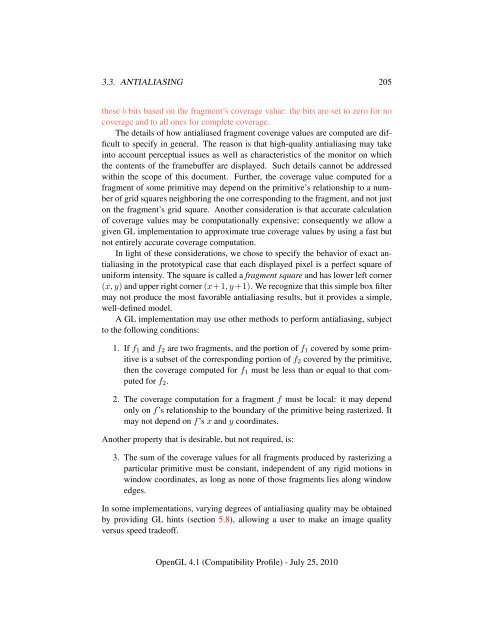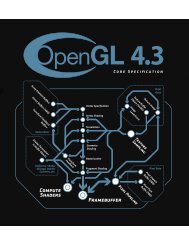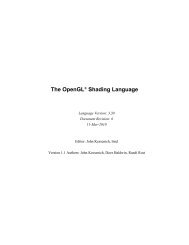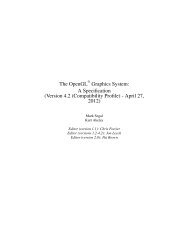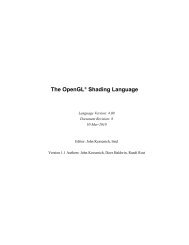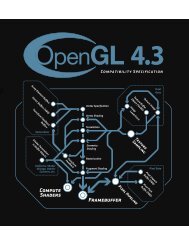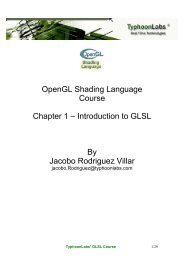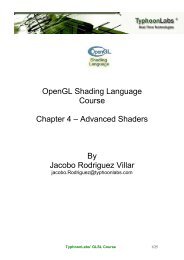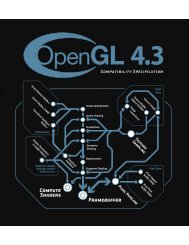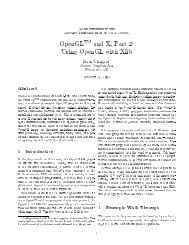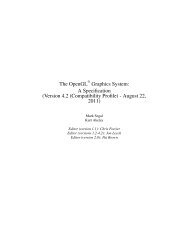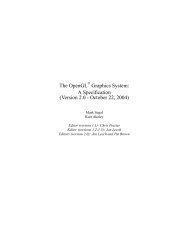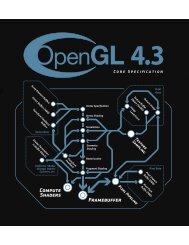- Page 1 and 2:
The OpenGL R○ Graphics System: A
- Page 3 and 4:
Contents 1 Introduction 1 1.1 Forma
- Page 5 and 6:
CONTENTS iii 2.15.2 Tessellation Pr
- Page 7 and 8:
CONTENTS v 3.14 Multisample Point F
- Page 9 and 10:
CONTENTS vii B Corollaries 548 C Co
- Page 11 and 12:
CONTENTS ix L.3.11 Vertex Blend . .
- Page 13 and 14:
CONTENTS xi L.3.91 Shader Precision
- Page 15 and 16:
LIST OF FIGURES xiii 3.11 Example o
- Page 17 and 18:
LIST OF TABLES xv 3.10 UNSIGNED_SHO
- Page 19 and 20:
LIST OF TABLES xvii 6.36 Renderbuff
- Page 21 and 22:
Chapter 1 Introduction This documen
- Page 23 and 24:
1.5. OUR VIEW 3 the CPU and the gra
- Page 25 and 26:
Chapter 2 OpenGL Operation 2.1 Open
- Page 27 and 28:
2.1. OPENGL FUNDAMENTALS 7 section
- Page 29 and 30:
2.1. OPENGL FUNDAMENTALS 9 Any repr
- Page 31 and 32:
2.1. OPENGL FUNDAMENTALS 11 2.1.2 F
- Page 33 and 34:
2.2. GL STATE 13 After conversion,
- Page 35 and 36:
2.4. BASIC GL OPERATION 15 Type Des
- Page 37 and 38:
2.4. BASIC GL OPERATION 17 Display
- Page 39 and 40:
2.6. BEGIN/END PARADIGM 19 Error De
- Page 41 and 42:
2.6. BEGIN/END PARADIGM 21 Vertex C
- Page 43 and 44:
2.6. BEGIN/END PARADIGM 23 first ve
- Page 45 and 46:
2.6. BEGIN/END PARADIGM 25 2 4 6 2
- Page 47 and 48:
2.6. BEGIN/END PARADIGM 27 Figure 2
- Page 49 and 50:
2.6. BEGIN/END PARADIGM 29 Primitiv
- Page 51 and 52:
2.7. VERTEX SPECIFICATION 31 to cha
- Page 53 and 54:
2.7. VERTEX SPECIFICATION 33 This c
- Page 55 and 56:
2.7. VERTEX SPECIFICATION 35 void C
- Page 57 and 58:
2.7. VERTEX SPECIFICATION 37 • si
- Page 59 and 60:
2.8. VERTEX ARRAYS 39 void VertexAt
- Page 61 and 62:
2.8. VERTEX ARRAYS 41 The index par
- Page 63 and 64:
2.8. VERTEX ARRAYS 43 void ArrayEle
- Page 65 and 66:
2.8. VERTEX ARRAYS 45 and Primitive
- Page 67 and 68:
2.8. VERTEX ARRAYS 47 not modified
- Page 69 and 70:
2.8. VERTEX ARRAYS 49 does not exis
- Page 71 and 72:
2.8. VERTEX ARRAYS 51 is a restrict
- Page 73 and 74:
2.8. VERTEX ARRAYS 53 The command v
- Page 75 and 76:
2.9. BUFFER OBJECTS 55 } } else Dis
- Page 77 and 78:
2.9. BUFFER OBJECTS 57 Name Type In
- Page 79 and 80:
2.9. BUFFER OBJECTS 59 Name Value B
- Page 81 and 82:
2.9. BUFFER OBJECTS 61 pointers, or
- Page 83 and 84:
2.9. BUFFER OBJECTS 63 void *MapBuf
- Page 85 and 86:
2.9. BUFFER OBJECTS 65 sizeiptr siz
- Page 87 and 88:
2.10. VERTEX ARRAY OBJECTS 67 ing t
- Page 89 and 90:
2.12. FIXED-FUNCTION VERTEX TRANSFO
- Page 91 and 92:
2.12. FIXED-FUNCTION VERTEX TRANSFO
- Page 93 and 94:
2.12. FIXED-FUNCTION VERTEX TRANSFO
- Page 95 and 96:
2.12. FIXED-FUNCTION VERTEX TRANSFO
- Page 97 and 98:
2.12. FIXED-FUNCTION VERTEX TRANSFO
- Page 99 and 100:
2.13. FIXED-FUNCTION VERTEX LIGHTIN
- Page 101 and 102:
2.13. FIXED-FUNCTION VERTEX LIGHTIN
- Page 103 and 104:
2.13. FIXED-FUNCTION VERTEX LIGHTIN
- Page 105 and 106:
2.13. FIXED-FUNCTION VERTEX LIGHTIN
- Page 107 and 108:
2.13. FIXED-FUNCTION VERTEX LIGHTIN
- Page 109 and 110:
2.13. FIXED-FUNCTION VERTEX LIGHTIN
- Page 111 and 112:
2.14. VERTEX SHADERS 91 2.14 Vertex
- Page 113 and 114:
2.14. VERTEX SHADERS 93 the text st
- Page 115 and 116:
2.14. VERTEX SHADERS 95 compiled to
- Page 117 and 118:
2.14. VERTEX SHADERS 97 obtain more
- Page 119 and 120:
2.14. VERTEX SHADERS 99 if (program
- Page 121 and 122:
2.14. VERTEX SHADERS 101 where pipe
- Page 123 and 124:
2.14. VERTEX SHADERS 103 or outputs
- Page 125 and 126:
2.14. VERTEX SHADERS 105 in length
- Page 127 and 128:
2.14. VERTEX SHADERS 107 Data type
- Page 129 and 130:
2.14. VERTEX SHADERS 109 After a pr
- Page 131 and 132:
2.14. VERTEX SHADERS 111 uniform bl
- Page 133 and 134:
2.14. VERTEX SHADERS 113 void GetAc
- Page 135 and 136:
2.14. VERTEX SHADERS 115 successful
- Page 137 and 138:
2.14. VERTEX SHADERS 117 If one or
- Page 139 and 140:
2.14. VERTEX SHADERS 119 OpenGL Sha
- Page 141 and 142:
2.14. VERTEX SHADERS 121 of the uni
- Page 143 and 144:
2.14. VERTEX SHADERS 123 If any of
- Page 145 and 146:
2.14. VERTEX SHADERS 125 • Member
- Page 147 and 148:
2.14. VERTEX SHADERS 127 matrix is
- Page 149 and 150:
2.14. VERTEX SHADERS 129 limit on t
- Page 151 and 152:
2.14. VERTEX SHADERS 131 will load
- Page 153 and 154:
2.14. VERTEX SHADERS 133 able writt
- Page 155 and 156:
2.14. VERTEX SHADERS 135 • the to
- Page 157 and 158:
2.14. VERTEX SHADERS 137 Instead, t
- Page 159 and 160:
2.14. VERTEX SHADERS 139 • the te
- Page 161 and 162:
2.14. VERTEX SHADERS 141 • The sa
- Page 163 and 164:
2.14. VERTEX SHADERS 143 This error
- Page 165 and 166:
2.14. VERTEX SHADERS 145 variable.
- Page 167 and 168:
2.15. TESSELLATION 147 of the outpu
- Page 169 and 170:
2.15. TESSELLATION 149 Tessellation
- Page 171 and 172:
2.15. TESSELLATION 151 whose tessel
- Page 173 and 174: 2.15. TESSELLATION 153 called the s
- Page 175 and 176: 2.15. TESSELLATION 155 float *value
- Page 177 and 178: 2.15. TESSELLATION 157 Figure 2.14.
- Page 179 and 180: 2.15. TESSELLATION 159 control the
- Page 181 and 182: 2.15. TESSELLATION 161 to subsequen
- Page 183 and 184: 2.15. TESSELLATION 163 the provided
- Page 185 and 186: 2.15. TESSELLATION 165 • The vari
- Page 187 and 188: 2.16. GEOMETRY SHADERS 167 the valu
- Page 189 and 190: 2.16. GEOMETRY SHADERS 169 vertices
- Page 191 and 192: 2.16. GEOMETRY SHADERS 171 • Flat
- Page 193 and 194: 2.16. GEOMETRY SHADERS 173 • Stru
- Page 195 and 196: 2.16. GEOMETRY SHADERS 175 The buil
- Page 197 and 198: 2.17. COORDINATE TRANSFORMATIONS 17
- Page 199 and 200: 2.17. COORDINATE TRANSFORMATIONS 17
- Page 201 and 202: 2.18. ASYNCHRONOUS QUERIES 181 retu
- Page 203 and 204: 2.19. CONDITIONAL RENDERING 183 2.1
- Page 205 and 206: 2.20. TRANSFORM FEEDBACK 185 return
- Page 207 and 208: 2.20. TRANSFORM FEEDBACK 187 Transf
- Page 209 and 210: 2.20. TRANSFORM FEEDBACK 189 itive
- Page 211 and 212: 2.21. PRIMITIVE QUERIES 191 is gene
- Page 213 and 214: 2.22. FLATSHADING 193 Primitive typ
- Page 215 and 216: 2.23. PRIMITIVE CLIPPING 195 lie in
- Page 217 and 218: 2.24. FINAL COLOR PROCESSING 197 ar
- Page 219 and 220: 2.25. CURRENT RASTER POSITION 199 c
- Page 221 and 222: 2.25. CURRENT RASTER POSITION 201 i
- Page 223: 203 Fixed function or fragment shad
- Page 227 and 228: 3.3. ANTIALIASING 207 have fixed sa
- Page 229 and 230: 3.4. POINTS 209 derived size = clam
- Page 231 and 232: ¡ ¡ ¡ ¡ ¡ ¡ 3.4. POINTS 211 5
- Page 233 and 234: 3.4. POINTS 213 All fragments produ
- Page 235 and 236: 3.5. LINE SEGMENTS 215 ported is eq
- Page 237 and 238: 3.5. LINE SEGMENTS 217 window-coord
- Page 239 and 240: 3.5. LINE SEGMENTS 219 width = 2 wi
- Page 241 and 242: 3.6. POLYGONS 221 is rasterized as
- Page 243 and 244: 3.6. POLYGONS 223 is disabled or th
- Page 245 and 246: 3.6. POLYGONS 225 If x w and y w ar
- Page 247 and 248: 3.6. POLYGONS 227 given polygon is
- Page 249 and 250: 3.7. PIXEL RECTANGLES 229 Parameter
- Page 251 and 252: 3.7. PIXEL RECTANGLES 231 Parameter
- Page 253 and 254: 3.7. PIXEL RECTANGLES 233 pack buff
- Page 255 and 256: 3.7. PIXEL RECTANGLES 235 defines a
- Page 257 and 258: 3.7. PIXEL RECTANGLES 237 R, G, B,
- Page 259 and 260: 3.7. PIXEL RECTANGLES 239 precisely
- Page 261 and 262: 3.7. PIXEL RECTANGLES 241 Histogram
- Page 263 and 264: ¡ ¡ ¡ ¡ ¡ ¡ ¡ ¡ ¡ ¡ ¡ ¡
- Page 265 and 266: 3.7. PIXEL RECTANGLES 245 Format Na
- Page 267 and 268: 3.7. PIXEL RECTANGLES 247 ROW_LENGT
- Page 269 and 270: 3.7. PIXEL RECTANGLES 249 an unsign
- Page 271 and 272: 3.7. PIXEL RECTANGLES 251 UNSIGNED_
- Page 273 and 274: 3.7. PIXEL RECTANGLES 253 Format Fi
- Page 275 and 276:
3.7. PIXEL RECTANGLES 255 3.7.5 Ras
- Page 277 and 278:
3.7. PIXEL RECTANGLES 257 (either z
- Page 279 and 280:
3.7. PIXEL RECTANGLES 259 must have
- Page 281 and 282:
3.7. PIXEL RECTANGLES 261 Base Filt
- Page 283 and 284:
3.7. PIXEL RECTANGLES 263 and C c i
- Page 285 and 286:
3.7. PIXEL RECTANGLES 265 ALPHA_BIA
- Page 287 and 288:
3.8. BITMAPS 267 ignored.) If a par
- Page 289 and 290:
3.9. TEXTURING 269 Bitmap Multisamp
- Page 291 and 292:
3.9. TEXTURING 271 specifies the ac
- Page 293 and 294:
3.9. TEXTURING 273 returns TRUE if
- Page 295 and 296:
3.9. TEXTURING 275 MIRRORED_REPEAT
- Page 297 and 298:
3.9. TEXTURING 277 elements in one
- Page 299 and 300:
3.9. TEXTURING 279 to a specific co
- Page 301 and 302:
3.9. TEXTURING 281 A preliminary sh
- Page 303 and 304:
3.9. TEXTURING 283 Sized internal c
- Page 305 and 306:
3.9. TEXTURING 285 Sized Base D S I
- Page 307 and 308:
3.9. TEXTURING 287 level of detail
- Page 309 and 310:
3.9. TEXTURING 289 • UNPACK_SKIP_
- Page 311 and 312:
3.9. TEXTURING 291 1.0 5.0 4 3 t v
- Page 313 and 314:
3.9. TEXTURING 293 defines a one-di
- Page 315 and 316:
3.9. TEXTURING 295 generates the er
- Page 317 and 318:
3.9. TEXTURING 297 • xoffset or y
- Page 319 and 320:
3.9. TEXTURING 299 of TEXTURE_WIDTH
- Page 321 and 322:
3.9. TEXTURING 301 This guarantee a
- Page 323 and 324:
3.9. TEXTURING 303 3.9.7 Buffer Tex
- Page 325 and 326:
3.9. TEXTURING 305 Internal formats
- Page 327 and 328:
3.9. TEXTURING 307 Texture paramete
- Page 329 and 330:
3.9. TEXTURING 309 Major Axis Direc
- Page 331 and 332:
3.9. TEXTURING 311 If λ(x, y) is l
- Page 333 and 334:
3.9. TEXTURING 313 Coordinate Wrapp
- Page 335 and 336:
3.9. TEXTURING 315 i 0 = wrap(⌊u
- Page 337 and 338:
3.9. TEXTURING 317 Figure 3.11. An
- Page 339 and 340:
3.9. TEXTURING 319 The values of le
- Page 341 and 342:
3.9. TEXTURING 321 3.9.12 Texture M
- Page 343 and 344:
3.9. TEXTURING 323 means that a tex
- Page 345 and 346:
3.9. TEXTURING 325 pixel data are t
- Page 347 and 348:
3.9. TEXTURING 327 Texture Base Tex
- Page 349 and 350:
3.9. TEXTURING 329 COMBINE_RGB Text
- Page 351 and 352:
3.9. TEXTURING 331 The state requir
- Page 353 and 354:
3.9. TEXTURING 333 reference value.
- Page 355 and 356:
3.9. TEXTURING 335 C f CT 0 CT 1 TE
- Page 357 and 358:
3.11. FOG 337 void Fog{if}( enum pn
- Page 359 and 360:
3.12. FRAGMENT SHADERS 339 MAX_FRAG
- Page 361 and 362:
3.12. FRAGMENT SHADERS 341 The resu
- Page 363 and 364:
3.12. FRAGMENT SHADERS 343 geometry
- Page 365 and 366:
3.12. FRAGMENT SHADERS 345 range co
- Page 367 and 368:
3.13. ANTIALIASING APPLICATION 347
- Page 369 and 370:
Chapter 4 Per-Fragment Operations a
- Page 371 and 372:
4.1. PER-FRAGMENT OPERATIONS 351 Fr
- Page 373 and 374:
4.1. PER-FRAGMENT OPERATIONS 353 st
- Page 375 and 376:
4.1. PER-FRAGMENT OPERATIONS 355 ma
- Page 377 and 378:
4.1. PER-FRAGMENT OPERATIONS 357 a
- Page 379 and 380:
4.1. PER-FRAGMENT OPERATIONS 359 4.
- Page 381 and 382:
4.1. PER-FRAGMENT OPERATIONS 361 Bl
- Page 383 and 384:
4.1. PER-FRAGMENT OPERATIONS 363 vo
- Page 385 and 386:
4.1. PER-FRAGMENT OPERATIONS 365 Th
- Page 387 and 388:
4.1. PER-FRAGMENT OPERATIONS 367 co
- Page 389 and 390:
4.2. WHOLE FRAMEBUFFER OPERATIONS 3
- Page 391 and 392:
4.2. WHOLE FRAMEBUFFER OPERATIONS 3
- Page 393 and 394:
4.2. WHOLE FRAMEBUFFER OPERATIONS 3
- Page 395 and 396:
4.2. WHOLE FRAMEBUFFER OPERATIONS 3
- Page 397 and 398:
4.2. WHOLE FRAMEBUFFER OPERATIONS 3
- Page 399 and 400:
4.2. WHOLE FRAMEBUFFER OPERATIONS 3
- Page 401 and 402:
¡ ¡ ¡ ¡ ¡ ¡ ¡ ¡ ¡ ¡ ¡ ¡
- Page 403 and 404:
4.3. DRAWING, READING, AND COPYING
- Page 405 and 406:
4.3. DRAWING, READING, AND COPYING
- Page 407 and 408:
4.3. DRAWING, READING, AND COPYING
- Page 409 and 410:
4.3. DRAWING, READING, AND COPYING
- Page 411 and 412:
4.3. DRAWING, READING, AND COPYING
- Page 413 and 414:
4.4. FRAMEBUFFER OBJECTS 393 If SAM
- Page 415 and 416:
4.4. FRAMEBUFFER OBJECTS 395 If a f
- Page 417 and 418:
4.4. FRAMEBUFFER OBJECTS 397 4.4.2
- Page 419 and 420:
4.4. FRAMEBUFFER OBJECTS 399 The co
- Page 421 and 422:
4.4. FRAMEBUFFER OBJECTS 401 error
- Page 423 and 424:
4.4. FRAMEBUFFER OBJECTS 403 void F
- Page 425 and 426:
4.4. FRAMEBUFFER OBJECTS 405 • Th
- Page 427 and 428:
4.4. FRAMEBUFFER OBJECTS 407 FRAMEB
- Page 429 and 430:
4.4. FRAMEBUFFER OBJECTS 409 • im
- Page 431 and 432:
4.4. FRAMEBUFFER OBJECTS 411 • At
- Page 433 and 434:
4.4. FRAMEBUFFER OBJECTS 413 4.4.5
- Page 435 and 436:
4.4. FRAMEBUFFER OBJECTS 415 Layer
- Page 437 and 438:
Chapter 5 Special Functions This ch
- Page 439 and 440:
5.1. EVALUATORS 419 Integers Reals
- Page 441 and 442:
5.1. EVALUATORS 421 The second way
- Page 443 and 444:
5.2. SELECTION 423 EvalCoord2(p *
- Page 445 and 446:
5.3. FEEDBACK 425 of each primitive
- Page 447 and 448:
5.4. TIMER QUERIES 427 Type coordin
- Page 449 and 450:
5.5. DISPLAY LISTS 429 started or s
- Page 451 and 452:
5.5. DISPLAY LISTS 431 provides an
- Page 453 and 454:
5.5. DISPLAY LISTS 433 Framebuffer
- Page 455 and 456:
5.7. SYNC OBJECTS AND FENCES 435 Pr
- Page 457 and 458:
5.7. SYNC OBJECTS AND FENCES 437 If
- Page 459 and 460:
5.8. HINTS 439 Target PERSPECTIVE_C
- Page 461 and 462:
6.1. QUERYING GL STATE 441 void Get
- Page 463 and 464:
6.1. QUERYING GL STATE 443 6.1.3 En
- Page 465 and 466:
6.1. QUERYING GL STATE 445 TEXTURE_
- Page 467 and 468:
6.1. QUERYING GL STATE 447 • form
- Page 469 and 470:
6.1. QUERYING GL STATE 449 6.1.5 Sa
- Page 471 and 472:
6.1. QUERYING GL STATE 451 format N
- Page 473 and 474:
6.1. QUERYING GL STATE 453 are used
- Page 475 and 476:
6.1. QUERYING GL STATE 455 the corr
- Page 477 and 478:
6.1. QUERYING GL STATE 457 target i
- Page 479 and 480:
6.1. QUERYING GL STATE 459 If sync
- Page 481 and 482:
6.1. QUERYING GL STATE 461 or size)
- Page 483 and 484:
6.1. QUERYING GL STATE 463 If pname
- Page 485 and 486:
6.1. QUERYING GL STATE 465 If pname
- Page 487 and 488:
6.1. QUERYING GL STATE 467 range[0]
- Page 489 and 490:
6.1. QUERYING GL STATE 469 return t
- Page 491 and 492:
6.1. QUERYING GL STATE 471 • If p
- Page 493 and 494:
6.1. QUERYING GL STATE 473 6.1.21 S
- Page 495 and 496:
6.2. STATE TABLES 475 Operations on
- Page 497 and 498:
6.2. STATE TABLES 477 when not usin
- Page 499 and 500:
6.2. STATE TABLES 479 Get value Typ
- Page 501 and 502:
6.2. STATE TABLES 481 Get value Typ
- Page 503 and 504:
6.2. STATE TABLES 483 Get value Typ
- Page 505 and 506:
6.2. STATE TABLES 485 Get value Typ
- Page 507 and 508:
6.2. STATE TABLES 487 Get value Typ
- Page 509 and 510:
6.2. STATE TABLES 489 Get value Typ
- Page 511 and 512:
6.2. STATE TABLES 491 Get value Typ
- Page 513 and 514:
6.2. STATE TABLES 493 Get value Typ
- Page 515 and 516:
6.2. STATE TABLES 495 Get value Typ
- Page 517 and 518:
6.2. STATE TABLES 497 Get value Typ
- Page 519 and 520:
6.2. STATE TABLES 499 Get value Typ
- Page 521 and 522:
6.2. STATE TABLES 501 Get value Typ
- Page 523 and 524:
6.2. STATE TABLES 503 Get value Typ
- Page 525 and 526:
6.2. STATE TABLES 505 Get value Typ
- Page 527 and 528:
6.2. STATE TABLES 507 Get value Typ
- Page 529 and 530:
6.2. STATE TABLES 509 Get value Typ
- Page 531 and 532:
6.2. STATE TABLES 511 Get value Typ
- Page 533 and 534:
6.2. STATE TABLES 513 Get value Typ
- Page 535 and 536:
6.2. STATE TABLES 515 Get value Typ
- Page 537 and 538:
6.2. STATE TABLES 517 Get value Typ
- Page 539 and 540:
6.2. STATE TABLES 519 Get value Typ
- Page 541 and 542:
6.2. STATE TABLES 521 Get value Typ
- Page 543 and 544:
6.2. STATE TABLES 523 Get value Typ
- Page 545 and 546:
6.2. STATE TABLES 525 Get value Typ
- Page 547 and 548:
6.2. STATE TABLES 527 Get value Typ
- Page 549 and 550:
6.2. STATE TABLES 529 Get Command M
- Page 551 and 552:
6.2. STATE TABLES 531 Get Command M
- Page 553 and 554:
6.2. STATE TABLES 533 Get value Typ
- Page 555 and 556:
6.2. STATE TABLES 535 Get value Typ
- Page 557 and 558:
6.2. STATE TABLES 537 Get value Typ
- Page 559 and 560:
6.2. STATE TABLES 539 Get value Typ
- Page 561 and 562:
6.2. STATE TABLES 541 Get value Typ
- Page 563 and 564:
A.2. MULTI-PASS ALGORITHMS 543 A.2
- Page 565 and 566:
A.4. TESSELLATION INVARIANCE 545 Ru
- Page 567 and 568:
A.5. WHAT ALL THIS MEANS 547 Rule 7
- Page 569 and 570:
549 stencil comparison function; it
- Page 571 and 572:
Appendix C Compressed Texture Image
- Page 573 and 574:
C.1. RGTC COMPRESSED TEXTURE IMAGE
- Page 575 and 576:
Appendix D Shared Objects and Multi
- Page 577 and 578:
D.2. SYNC OBJECTS AND MULTIPLE CONT
- Page 579 and 580:
D.3. PROPAGATING CHANGES TO OBJECTS
- Page 581 and 582:
E.1. CORE AND COMPATIBILITY PROFILE
- Page 583 and 584:
E.2. DEPRECATED AND REMOVED FEATURE
- Page 585 and 586:
E.2. DEPRECATED AND REMOVED FEATURE
- Page 587 and 588:
Appendix F Version 3.0 and Before O
- Page 589 and 590:
F.3. CHANGED TOKENS 569 New Token N
- Page 591 and 592:
F.5. CREDITS AND ACKNOWLEDGEMENTS 5
- Page 593 and 594:
F.5. CREDITS AND ACKNOWLEDGEMENTS 5
- Page 595 and 596:
G.2. DEPRECATION MODEL 575 state ha
- Page 597 and 598:
G.4. CREDITS AND ACKNOWLEDGEMENTS 5
- Page 599 and 600:
Appendix H Version 3.2 OpenGL versi
- Page 601 and 602:
H.4. CHANGE LOG 581 New Token Name
- Page 603 and 604:
H.5. CREDITS AND ACKNOWLEDGEMENTS 5
- Page 605 and 606:
H.5. CREDITS AND ACKNOWLEDGEMENTS 5
- Page 607 and 608:
I.2. DEPRECATION MODEL 587 ing fact
- Page 609 and 610:
I.4. CREDITS AND ACKNOWLEDGEMENTS 5
- Page 611 and 612:
J.1. NEW FEATURES 591 • Mechanism
- Page 613 and 614:
J.4. CREDITS AND ACKNOWLEDGEMENTS 5
- Page 615 and 616:
Appendix K Version 4.1 OpenGL versi
- Page 617 and 618:
K.5. CREDITS AND ACKNOWLEDGEMENTS 5
- Page 619 and 620:
Appendix L Extension Registry, Head
- Page 621 and 622:
L.3. ARB EXTENSIONS 601 L.3.2 be am
- Page 623 and 624:
L.3. ARB EXTENSIONS 603 L.3.13 Text
- Page 625 and 626:
L.3. ARB EXTENSIONS 605 L.3.28 Open
- Page 627 and 628:
L.3. ARB EXTENSIONS 607 The name st
- Page 629 and 630:
L.3. ARB EXTENSIONS 609 equivalent
- Page 631 and 632:
L.3. ARB EXTENSIONS 611 L.3.59 Seam
- Page 633 and 634:
L.3. ARB EXTENSIONS 613 The name st
- Page 635 and 636:
L.3. ARB EXTENSIONS 615 L.3.84 Tess
- Page 637 and 638:
L.3. ARB EXTENSIONS 617 L.3.97 Cont
- Page 639 and 640:
INDEX 619 519 ACTIVE UNIFORM BLOCKS
- Page 641 and 642:
INDEX 621 CallList, 31, 430, 431, 5
- Page 643 and 644:
INDEX 623 RGTC2, 280, 285, 554 COMP
- Page 645 and 646:
INDEX 625 DEPTH FUNC, 500 DEPTH RAN
- Page 647 and 648:
INDEX 627 EvalCoord1f, 421 EvalCoor
- Page 649 and 650:
INDEX 629 FramebufferRenderbuffer,
- Page 651 and 652:
INDEX 631 GetQueryObjectiv, 457, 52
- Page 653 and 654:
INDEX 633 GL ARB texture cube map a
- Page 655 and 656:
INDEX 635 HISTOGRAM ALPHA SIZE, 453
- Page 657 and 658:
INDEX 637 layout, 126 LEFT, 360, 37
- Page 659 and 660:
INDEX 639 MAX CLIP DISTANCES, 528,
- Page 661 and 662:
INDEX 641 MAX TRANSFORM FEEDBACK -
- Page 663 and 664:
INDEX 643 PACK IMAGE HEIGHT, 382, 4
- Page 665 and 666:
INDEX 645 101, 143, 464 PROGRAM BIN
- Page 667 and 668:
INDEX 647 189, 190 RETURN, 379 RG,
- Page 669 and 670:
INDEX 649 SECONDARY COLOR ARRAY - P
- Page 671 and 672:
INDEX 651 TESS GEN VERTEX ORDER, 46
- Page 673 and 674:
INDEX 653 TEXTURE CUBE MAP POS- ITI
- Page 675 and 676:
INDEX 655 Uniform*i{v}, 121, 122 Un
- Page 677 and 678:
INDEX 657 UNSIGNED SHORT 5 6 5 REV,


